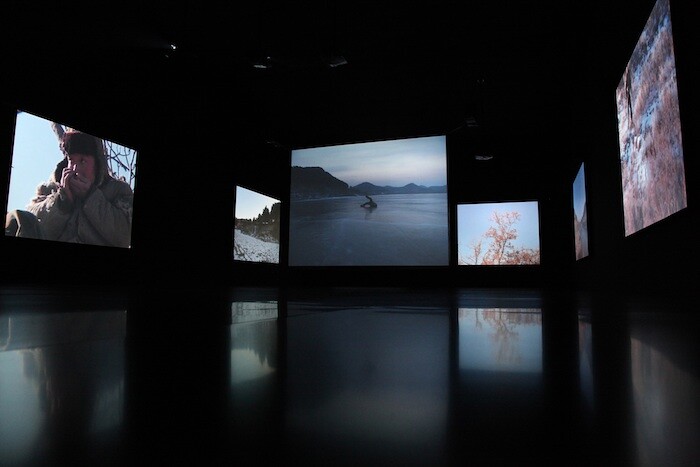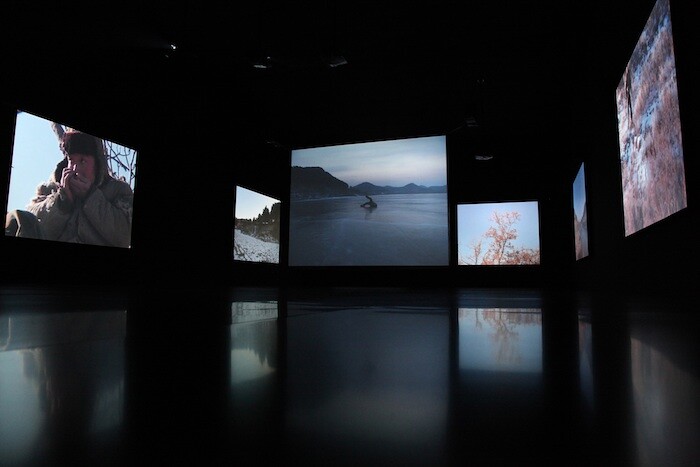In the mannered world evoked in the best-known films and video installations of Yang Fudong, people don’t speak much, perhaps because they have nothing to say. Instead, they preen and posture, as if posing for the still photographs they also appear in. A moody, attractive bunch, they tend to dress up, get together, and mull things over in silence: nonetheless, one believes they have a lot on their minds. In their evening gowns and well-cut suits, they glide effortlessly through a contemporary world of penthouse apartments and cocktail parties and an imaginary, gilded era of interwar Shanghai. Yang’s first solo show in Beijing brings together two large-scale installations that form the exhibition’s core, as well as a selection of black-and-white photographs related to Yang’s five-part film cycle Seven Intellectuals in a Bamboo Forest (2003–2007). In doing so, the exhibition highlights Yang’s tendency to favor highly stylized atmospherics over conventional narrative structures, revealing both the strengths and weaknesses of this approach when applied to multi-channel video works.
Visitors entering ARTMIA Gallery (located just opposite ShanghART’s Beijing space) first pass through a dim anteroom, empty except for a series of paragraphs decorating its dark walls at equidistant intervals. Bringing to mind a wayward Kosuth show, the texts—quotations excerpted from interviews with Yang—are part of an unfortunate trend in Beijing exhibition design. The problem is not one of translation, but of content. “Each plant will have its own beauty, such as a wild flower,” the artist tells us in one. “Maybe the power of such beauty is not very strong,” he concludes, “but it will somehow touch you one day.”
In the meantime, skip the bromides and advance directly to the adjacent room, where Yang’s arresting ten-channel video installation, The Revival of the Snake (2005), evokes nature’s harsh, indifferent beauty with far more eloquence. Here, under a cold, clear sky, an exiled soldier tries to stay alive despite the elements—taking an axe to a frozen lake in search of water and building a fire to keep warm through the night. The situation unfolds as if seen through a kaleidoscope, with desperate vignettes playing out across the work’s ten synchronized projections and bound by a haunting, ambient musical score. The pieces of this traumatic narrative are well suited to its fragmentary presentation. As we weave between the screens, the work suggests the exile’s interior world, a state of physical and psychological breakdown in which past and present, fact and fantasy have begun to blur. While many of the figures in Yang’s works have a certain aimless, unfocused quality, here the protagonist’s thousand-yard stare seems justified, perhaps by what the French writer Colette once called “the aurora borealis of starvation.” No matter how aestheticized, these images of an exiled rebel struggling for survival have an unexpected confluence with China’s present-day reality, which only strengthens the work’s magnetic field.
At ShanghART Beijing, the multi-channel installation Close to the Sea (2004) offers up a doomed love affair between two conventionally appealing beachcombers. In one video, shot in grainy black and white, a young couple is shown frolicking at the seashore. They stroke each other’s hair; she covers him in sand. Later, they ride a white horse. Their gestures are self-conscious, and the actors seem acutely aware that they are being filmed. In another, opposing projection, the lovers (or their doppelgangers) appear in color, trying to stay afloat in the now violent ocean on a tiny, makeshift raft; eventually they wash ashore. Apparently, theirs is a difficult love. Yet even near death, they remain implacably photogenic: Yang’s camera worships them. Ringing the hall’s perimeter are eight additional projections, depicting formally dressed musicians who perform a brooding, dissonant soundtrack keyed to the couple’s relationship. When not playing their instruments, the band stands rigidly atop the sea-sprayed rocks, staring vacantly toward something out of frame, a Greek chorus waiting to comment. At times, Close to the Sea brings to mind an attractive, twenty-three minute perfume ad.
Of course, Yang Fudong isn’t selling anything. If Close to the Sea and the photographs at ShanghART Beijing appear to appropriate the familiar language of fashion photography, this reflects Yang’s attempts to use beauty to provoke a critical response in viewers. Much has been written in an effort to piece together the fractured, dreamlike storylines of Yang’s films and video installations, but they are largely beside the point. Underneath the cinematic sheen that characterizes much of Yang’s work—the carefully composed tracking shots, the elegant costumes, and seductive close-ups—is an artistic practice fueled by an intuitive pursuit of images and a strong faith in their power to awaken our emotions. Rather like an operatic soprano who, discovering she can hit certain high notes, spends all her time shattering glass, Yang Fudong is a virtuoso at conjuring gorgeous pictures—a powerful gift that grows tedious when misused.






